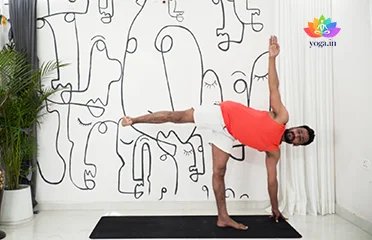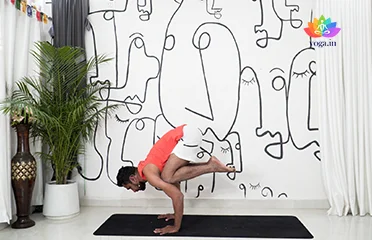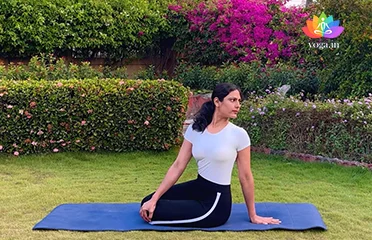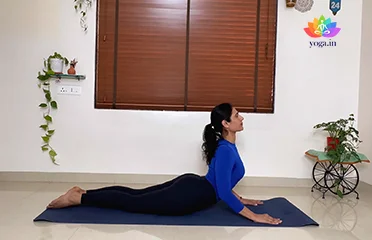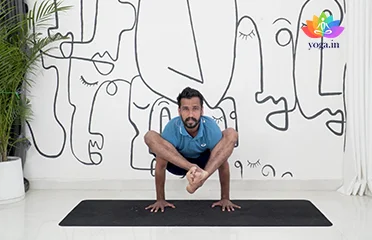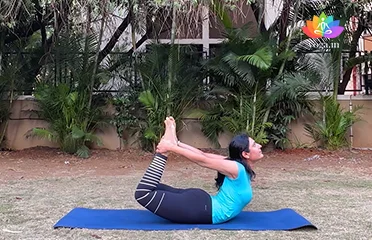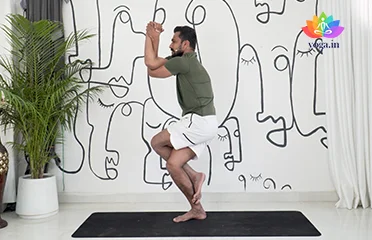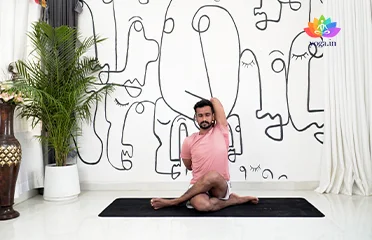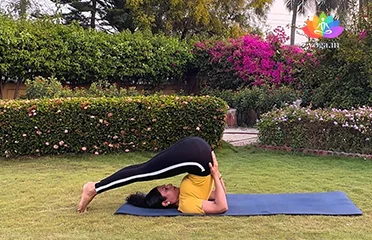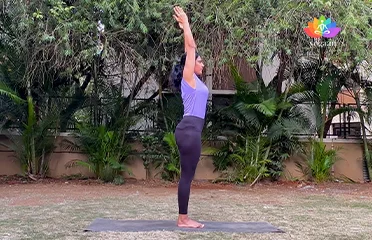Ardha Chandrasana (Half Moon Pose)
अर्धचन्द्रासना / Half Moon Pose
The Sanskrit name is derived from Ardha (अर्ध) meaning half, Chandra [�K]
Bakasana (Crane Pose)
बकासन / Crane Pose
The Sanskrit name is derived from Baka (बक) meaning crane or Kaka (काक) [�K]
Bharadvajasana (Seated Spinal Twist)
भरद्वाजसन / Seated Spinal Twist
The Sanskrit name is derived from Bhardvaja (भरद्वाज) means bringing [�K]
Bhujangasana (Cobra Pose)
भुजंगासन / Cobra Pose
The Sanskrit name is derived from Bhujanga (भुजंगा) meaning cobra [�K]
Bhujapidasana (Shoulder-Pressing Pose)
भुजपीडासन / Shoulder-Pressing Pose
The Sanskrit name is derived from Bhuja (भुज) meaning arm/shoulder, Pida [�K]
Dhanurasana (Bow Pose)
धनुरासन / Bow Pose
The Sanskrit name is derived from Dhanur (धनुर) means bow and Asana [�K]
Garudasana (Eagle Pose)
गरुडासन / Eagle Pose
The Sanskrit name is derived from Garuda (गरुडा) meaning eagle and [�K]
Gomukhasana (Cow Face Pose)
गोमुखासन / Cow Face Pose
The Sanskrit name is derived from Gau (गो) meaning cow, Mukh meaning face [�K]
Halasana (Plough Pose)
हलासन / Plough Pose
The Sanskrit name is derived from Hala (हला) meaning plough and asana [�K]
Hastapadasana (Hand to Foot Pose)
हस्तपदासन / Hand to Foot Pose
The sanskrit name is derived from hasta (हस्त) means hands, pada (पदा) [�K]
- 1
- 2
- 3
How Yoga Can Help Cure Rheumatic Pains:
Rheumatic pains, often associated with conditions like arthritis, involve chronic inflammation and discomfort in the joints and muscles. Yoga can significantly aid in the treatment and relief of these pains. Through gentle stretching, strengthening exercises, and relaxation techniques, yoga helps reduce inflammation, improve joint flexibility, and enhance overall physical and mental well-being.
Understanding Rheumatic Pains:
Rheumatic pains encompass a range of conditions characterized by inflammation, pain, and swelling in the joints and muscles. Common types include rheumatoid arthritis, osteoarthritis, and fibromyalgia. These conditions can lead to stiffness, decreased mobility, and a reduced quality of life.
Yoga’s Role in Relieving Rheumatic Pains:
Specific yoga practices can help alleviate the symptoms of rheumatic pains by improving joint flexibility, reducing inflammation, and enhancing muscle strength. Techniques such as gentle asanas (postures), pranayama (breathing exercises), and meditation promote relaxation and mental clarity, which are crucial for managing chronic pain.
Key Factors Contributing to Rheumatic Pains:
Several factors can contribute to the development of rheumatic pains, including:
- Genetic Predisposition: A family history of rheumatic conditions increases the risk.
- Age: The risk of rheumatic pains increases with age.
- Autoimmune Reactions: The immune system attacking the body’s tissues.
- Infections: Certain bacterial and viral infections can trigger rheumatic conditions.
- Obesity: Excess weight puts additional strain on joints.
- Joint Injuries: Previous injuries can increase the risk of rheumatic pains.
Symptoms of Rheumatic Pains:
Common symptoms of rheumatic pains include:
- Joint Pain: Persistent pain in the joints, often described as aching or throbbing.
- Swelling: Inflammation and swelling in the affected joints.
- Stiffness: Difficulty in moving joints, especially after periods of inactivity.
- Fatigue: Chronic tiredness and lack of energy.
- Redness and Warmth: Joints may appear red and feel warm to the touch.
- Limited Range of Motion: Difficulty in fully moving the affected joints.
- Muscle Pain: Aching or soreness in the muscles surrounding the joints.
Treatment of Rheumatic Pains through Yoga and Pranayama:
Yoga and pranayama can be highly effective in managing rheumatic pains. Some beneficial practices include:
Specific Yoga Poses:
- Tadasana (Mountain Pose): Improves posture and balance.
- Vrikshasana (Tree Pose): Enhances balance and strengthens legs.
- Setu Bandhasana (Bridge Pose): Strengthens back muscles and relieves tension.
Pranayama Exercises:
- Anulom Vilom (Alternate Nostril Breathing): Balances the mind and reduces stress.
- Ujjayi (Ocean Breath): Soothes the nervous system and reduces stress.
Diet for Rheumatic Pains:
A balanced diet can help manage rheumatic pains. Recommendations include:
- Anti-Inflammatory Foods: Include turmeric, ginger, and leafy greens to reduce inflammation.
- Omega-3 Fatty Acids: Found in fish, flaxseeds, and walnuts, these support joint health.
- High-Fiber Foods: Fruits, vegetables, and whole grains aid digestion and overall health.
- Lean Proteins: Chicken, fish, and legumes provide essential nutrients for muscle repair.
- Hydration: Drink plenty of water to stay hydrated and support joint function.
Caution for Rheumatic Pains:
While practicing yoga for rheumatic pains, it is essential to:
- Avoid Overexertion: Practice at a gentle pace to prevent strain on the joints.
- Be Mindful of Pain: Stop immediately if any pose causes discomfort or pain.
Always consult with a healthcare provider before starting any new exercise regimen, especially if you have severe rheumatic pains.
Contraindications for Rheumatic Pains:
Individuals with severe rheumatic pains or significant joint damage should:
- Avoid High-Intensity Yoga: Vigorous practices might exacerbate symptoms.
- Steer Clear of Certain Poses: Inversions and poses that put pressure on affected joints may increase discomfort.
- Seek Professional Guidance: Consult a yoga therapist or healthcare professional for personalized recommendations.


